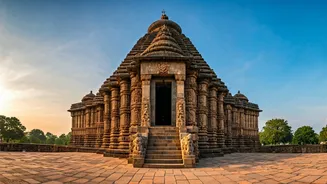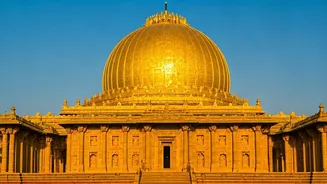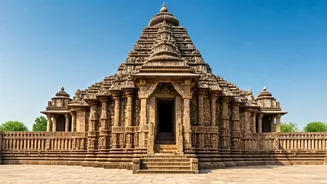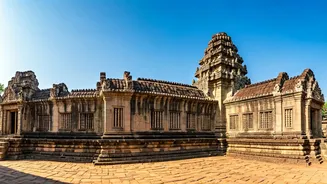Sun Temples' Legacy
Sun temples, scattered throughout India, stand as enduring symbols of ancient architectural prowess and spiritual devotion. These structures, dedicated
to the Sun God, Surya, are not merely places of worship; they are historical chronicles carved in stone, each narrating tales of bygone eras and the civilizations that flourished then. The design of these temples often reflects intricate knowledge of astronomy and geometry. The orientation of the structures, the placement of the windows, and the precise angles all suggest a deep understanding of celestial movements. Every carving, every sculpture, and every architectural detail contributes to a grand narrative, making each temple a repository of history and a monument to the enduring human quest for understanding and connection with the cosmos.
Konark's Architectural Grandeur
The Sun Temple at Konark, in Odisha, is a UNESCO World Heritage site and an emblem of the Kalinga architecture. Constructed in the 13th century, its design is strikingly unique, depicting a colossal chariot of the sun god. The temple's 24 wheels, sculpted with intricate detail, symbolize the cycles of time. The structure is adorned with detailed carvings, depicting mythological stories, everyday life, and various aspects of the culture of that time. Originally built near the coastline, the erosion caused by the sea has affected the structure over centuries, but the remaining complex still showcases exceptional craftsmanship, and the temple stands as a testament to the artistic heights reached during the Ganga dynasty. The temple complex attracts thousands of tourists and pilgrims annually, who come to marvel at its splendor and pay their respects.
Modhera's Celestial Alignment
Located in Gujarat, the Sun Temple at Modhera, built in the early 11th century, is another remarkable example of temple architecture. This temple is famous for its intricate carvings and precise geometrical designs. The structure is strategically positioned, allowing sunlight to illuminate the central deity during the equinoxes. The temple is composed of three main parts: the 'Surya Kund', a stepped tank, the 'Sabha Mandap', or the assembly hall, and the 'Gudha Mandap', the sanctum where the idol of Surya was placed. Each section is meticulously carved, portraying scenes from the Ramayana, Mahabharata, and various other mythological stories. The temple’s design also reflects the Solanki dynasty's appreciation for arts and sciences. This temple's celestial alignment and its artistic detailing make it a must-visit destination, as it embodies the rich cultural heritage of India.
Martand's Kashmir Splendor
The Martand Sun Temple in Jammu and Kashmir, built during the 8th century, offers a unique blend of Indian and Greco-Roman architectural styles. The temple, situated on a plateau, provides a panoramic view of the Kashmir valley. The temple complex is centered around a main shrine, encircled by a colonnade of 84 pillars. Each pillar, along with the walls, showcases an amazing level of detail, with intricate carvings that depict various figures from Hindu mythology. The temple was destroyed during the 15th century, but the ruins remain majestic, offering a glimpse of the architectural brilliance of the Karkota dynasty. Despite its ruined state, the site still evokes a sense of grandeur, and the architectural remnants reflect a confluence of different cultural influences. Visitors come here not only to appreciate the historical significance but also to admire the stunning natural beauty that surrounds the temple.
Other Notable Temples
Besides Konark, Modhera, and Martand, other sun temples in India offer unique experiences. The complex at Katarmal, in Uttarakhand, is known for its intricate wood carvings and vibrant atmosphere. The temple at Unao, in Madhya Pradesh, houses a unique idol of the sun god. Each temple boasts distinct architecture, and showcases unique artistic and cultural heritage of different eras. Visiting these temples provides a valuable understanding of India's diverse traditions and architectural evolution. The unique characteristics of each temple provide a comprehensive perspective on the varied forms of worship and the artistic expressions across different regions. These sites together form a compelling narrative of India's artistic and spiritual landscape, and a deeper exploration of each site can enhance the appreciation of the country's rich historical and cultural tapestry.











